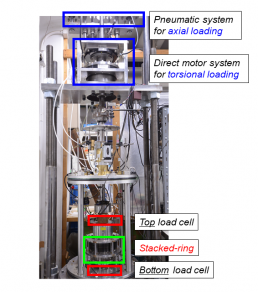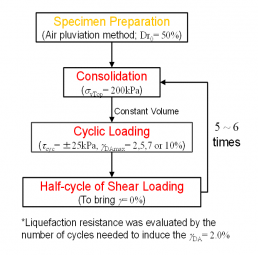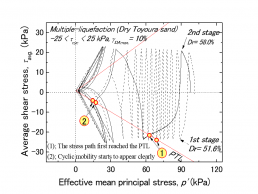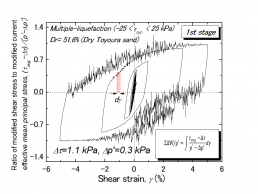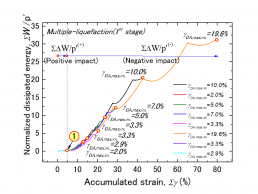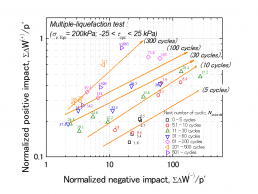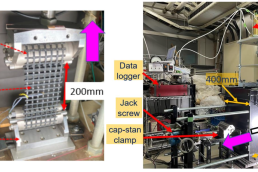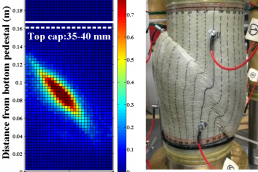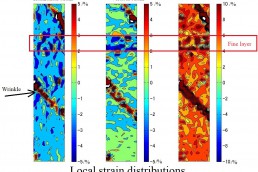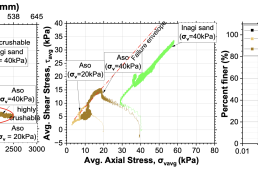Introduction / はじめに
Multiple-liquefaction phenomenon gained much attention after the 2010/2011 Canterbury earthquakes in New Zealand.
To understand multiple-liquefaction properties, several series of multiple-liquefaction tests were conducted using “Stacked-ring shear apparatus”. The test results are summarized in terms of the change in the number of cycles to cause γDA=2.0 %.
2010/2011年にニュージランドで発生したクライストチャーチ地震や東北地方太平洋沖地震では,同一箇所で3回以上の連続した“複数回液状化現象”が各地で確認された.3回以上の液状化履歴を受けた豊浦砂の挙動の把握を目的として,これまで「多層リングせん断試験装置」を用いた一連の“複数回液状化試験”を実施してきた.図には,両振幅せん断ひずみ γDA= 2.0%に至るまでの繰返し回数(液状化強度)の変化を示してある.
Fig.1 Outline of stacked-ring shear apparatus
Fig2. Experimental procedure
Fig3. Multiple liquefaction tests result
Methodology of Dissipated Energy Analysis / エネルギーを用いた分析手法
In order to reveal the effects of multiple strain histories on the behavior of re-liquefied Toyoura sand, analysis was conducted by using the dissipated energy ΣΔW that has been normalized by the current effective mean principal stress p’. It is noted that stress ratio τavg./p’ and shear strain γ relationship were modified by introducing correction method (Δτ and Δp’) under low confining stress state (around the origin of effective stress path). The normalized dissipated energy ΣΔW/p’ was defined as the hysteresis area of the ratio of modified shear stress (τavg.–Δτ)/(p’-Δp’) and shear strain γ relationship.
様々な液状化履歴を受けた豊浦砂の再液状化挙動を詳細に検討するために,現在の平均有効応力p’で正規化した消散エネルギーΣΔW を用いた分析を実施してきた.正規化消散エネルギーΣΔW/p’を算出する際に用いた応力比-ひずみ関係((τavg.–Δτ)/(p’-Δp’) –γ)は,有効応力経路における原点付近(低拘束圧状態)の補正量(ΔτとΔp’)を考慮したものを用いている.
Fig.4 Re-liquefaction effective stress path
Fig.5 Ratio of modified shear stress and shear strain
Fig.6 Relationships between normalized dissipated energy and accumulated strain
Normalized Dissipated Energy Analysis Results / 正規化消散エネルギーを用いた分析結果
The normalized dissipated energy ΣΔW/p’ was separated into two types components: one with positive impact ΣΔW(+)/p’ to dissipate before reaching “Phase Transformation Line (PTL)” (the state (1)) and the other negative impact ΣΔW(-) /p’ to dissipate after passing PTL. The combination of (ΣΔW(+) /p’ )i and (ΣΔW(+) /p’ )i in the current liquefaction stage affect uniquely the liquefaction behavior (N γDA=2.0 %)i+1 in the next liquefaction stage.
補正した応力比-ひずみ関係の履歴ループより算出した正規化消散エネルギーを,変相線(図中の点①に対応)に到達する以前のエネルギー分“正の効果ΣΔW(+)/p’ ”と,変相線に到達後のエネルギー分“負の効果ΣΔW(-) /p’ ”の2種類に分けて分析を行った.既往の研究より,正の効果(負の効果)のエネルギー分が大きいほど,次の液状化段階における強度が増加(減少)することがわかっている.分析の結果,現在の液状化段階における“正負の効果”の組合せ(ΣΔW(+) /p’ )iと(ΣΔW(+) /p’ )i は,次の液状化段階における液状化強度(再液状化強度; (N γDA=2.0 %)i+1)と良好な相関関係があることがわかった.
Fig.7 Relationships among normalized positive and negative impacts and the number of cycles in the next liquefaction
More Details...
1)Seto Wahyudi, Junichi Koseki. “Analysis of re-liquefaction properties on energy approach”, Bulletin of Earthquake Resistant Structure Research Center (ERS), Institute of Industrial Science, the University of Tokyo, No.48, pp.51-61, 2015.
2)青柳悠大,古関潤一,佐藤剛司,宮下千花. “複数回液状化時の特性変化に関する多層リング繰返し単純せん断試験(その3)”,第50回地盤工学研究発表会,札幌,2015年9月.
3)青柳悠大,古関潤一,Seto Wahyudi. “複数回液状化試験における消散エネルギーの正負の効果に着目した分析”,土木学会全国大会第70回年次学術講演会,岡山,2015年9月.
4)古関潤一,Seto Wahyudi,青柳悠大. “消散エネルギーに着目した複数回液状化試験結果の分析”,土木学会全国大会第70回年次学術講演会,岡山,2015年9月.
5)青柳悠大,Seto Wahyudi,古関潤一,佐藤剛司,宮下千花.“大小様々な液状化ひずみ履歴を与えた複数回液状化試験と消散エネルギーを用いた分析”,土木学会論文集A1 (構造・地震工学),土木学会,72(2016), No.4, pp.I_167-I_176, 2016.
6)青柳悠大,古関潤一. “複数回液状化試験結果における消散エネルギーを用いた分析方法の検討”,土木学会全国大会第71回年次学術講演会,仙台,2016年6月.
7)青柳悠大,古関潤一.“平均有効主応力で正規化した消散エネルギーに基づく複数回液状化試験の分析”,第52回地盤工学研究発表会,名古屋,2017年7月.
8)山崎佑太朗,古関潤一,青柳悠大. “平均有効主応力で正規化した消散エネルギーに基づく豊浦砂の再液状化特性の定式化”,第52回地盤工学研究発表会,名古屋,2017年7月.
9)Yudai Aoyagi and Junichi Koseki “Analysis of multiple liquefaction characteristics of Toyoura sand based on dissipated energy”, 3rd International Conference on Performance-based Design in Earthquake Geotechnical Engineering, Vancouver, Canada, July 2017.
10)山崎佑太朗,青柳悠大,古関潤一. “消散エネルギーを用いた豊浦砂の再液状化特性の定式化”,土木学会全国大会第72回年次学術講演会,福岡,2017年9月.
11)Yudai Aoyagi and Takeshi Sato “Energy-based investigation of multiple liquefaction properties of sand subjected to different strain histories”, 19th International Conference on Soil Mechanics and Geotechnical Engineering, Seoul, Korea, Sept. 2017.
